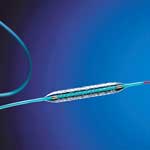Drug-eluting stents evaluated in head-to-head comparison trials
Sirolimus-eluting stent found more effective for preventing restenosis in diabetic patients.
ORLANDO — A head-to-head comparison of two drug-eluting stents showed a slight edge for the sirolimus-eluting stent among patients with diabetes, while another found that both stents are safe and effective with no significant differences in restenosis rates.
In a late-breaking trial presentation at the American College of Cardiology Annual Scientific Session 2005, Adnan Kastrati, MD, professor of cardiology at Deutsches Herzzentrum in Munich, said the sirolimus-eluting Cypher stent (Cordis Johnson & Johnson) was more effective at preventing restenosis in diabetics.
A second late-breaking trial, the REALITY trial, found a higher rate of stent thromboses with the paclitaxel-eluting stent (Taxus, Boston Scientific), but the principal investigator said the data are insufficient to select one stent over the other.
ISAR-Diabetes results
The randomized ISAR-Diabetes noninferiority trial enrolled 250 patients with diabetes at one center that were randomized to either the sirolimus-eluting stent or to the paclitaxel-eluting stent. Angiographic follow-up was at six to eight months.
Angiographic late lumen loss at follow-up, the primary endpoint, was 0.43 mm in the sirolimus group and 0.67 mm in the paclitaxel group (P<.001). Angiographic restenosis was 6.9% in the sirolimus group and 16.5% in the paclitaxel group (P=.03). Target lesion revascularization was 6.4% in the sirolimus group and 12% of the paclitaxel group (P=.013).
At nine months, mortality was 3.2% in the sirolimus group and 4.8% in the paclitaxel group.
Because diabetics have the smallest vessels, it is “important to have a low late loss rate, particularly in this population,” Kastrati said. He said the data indicate that the Cypher stent is “more effective at preventing restenosis in this high-risk group of patients.”
There was a 100% success rate with both stents in terms of navigation. “The data demonstrate the safety of both stents in these patients,” he said.
 Cypher Sirolimus-eluting stent Cordis Corp. |
 Taxus Paclitaxel-eluting stent Boston Scientific |
In a response to the results, Theodore A. Bass, MD, an interventional cardiologist at the University of Florida College of Medicine, said he was not surprised that differences are emerging between the two stents as there are differences between the drugs, stent designs and polymers.
Bass said that treating a single lesion is rarely the primary aim in the treatment of diabetic patients. Instead, more systemic therapy is needed, including treatment of increased inflammation, altered endothelial function and systemic vascular disease.
REALITY trial
Results of the REALITY trial — a randomized, prospective, multicenter trial — showed significantly fewer stent thromboses with the sirolimus-eluting stent vs. the paclitaxel-eluting stent.
In her late-breaking presentation, Marie-Claude Morice, MD, head of interventional cardiology at the Institut Hospitalier Jacques Cartier, Massy, France, said that within the first 30 days of the trial, the rate of stent thromboses for patients receiving the sirolimus stent was 0.4 vs. 1.8 in patients receiving the paclitaxel stent (P=.0196). All other clinical results at eight months were not significant.
REALITY included 1,353 patients with a total of 1,911 lesions. The trial was conducted at 95 centers in 25 countries. All patients had had antiplatelet therapy for at least two months and had one or two de novo lesions in a native coronary artery between 2.25 mm and 3.00 mm diameter.
The primary endpoint was in-lesion binary restenosis at eight months; secondary endpoints included major adverse cardiac events up to 24 months.
Effective treatment
Morice said the in-stent, in-segment, proximal and distal restenosis rates were not significant between the two stents.
Several significant differences were identified between the two stents: in-lesion mean lumen diameter: 1.79 mm for sirolimus-eluting vs. 1.71 for paclitaxel-eluting (P<.001); in-stent percent stenosis: 23.11% for sirolimus-eluting vs. 26.70% for paclitaxel (P<.001); in-stent late loss: 0.09 mm vs. 0.31 mm, respectively; and in-segment late loss: 0.04 vs. 0.16, respectively (P<.001).
“Both stents were very effective in treating the lesions,” Morice said.
The higher rate of acute and subacute thrombosis, she said, was “the first time we have seen differences in safety between the two stents. However, there are not enough data to select one stent over the other. For me as a doctor, these results will not make me change my prescription for patients,” Morice said. “We need much more data to dramatically change practice.”
In his comments about the research, fellow REALITY researcher Eberhard Grube, MD, at the Heart Center Siegberg, Germany, noted that there were no significant differences in major adverse cardiac events, death or MI between the two stents and that more data are needed before conclusions can be drawn. – by Kathy Holliman
For more information:
- Kastrati A, Dibra A, Mehilli J et al. Paclitaxel-eluting stent versus sirolimus-eluting stent for the prevention of restenosis in diabetic patients with coronary artery disease. Late-breaking trial presented at the American College of Cardiology Annual Scientific Session 2005. March 6-9, 2005. Orlando.
- Morice MC, Serruys P, Colombo A. Eight-month outcome of the Reality study: a prospective randomized multi-center head-to-head comparison of the sirolimus-eluting stent (Cypher) and the paclitaxel-eluting stent (Taxus). Late-breaking trial presented at the American College of Cardiology Annual Scientific Session 2005. March 6-9, 2005. Orlando.
